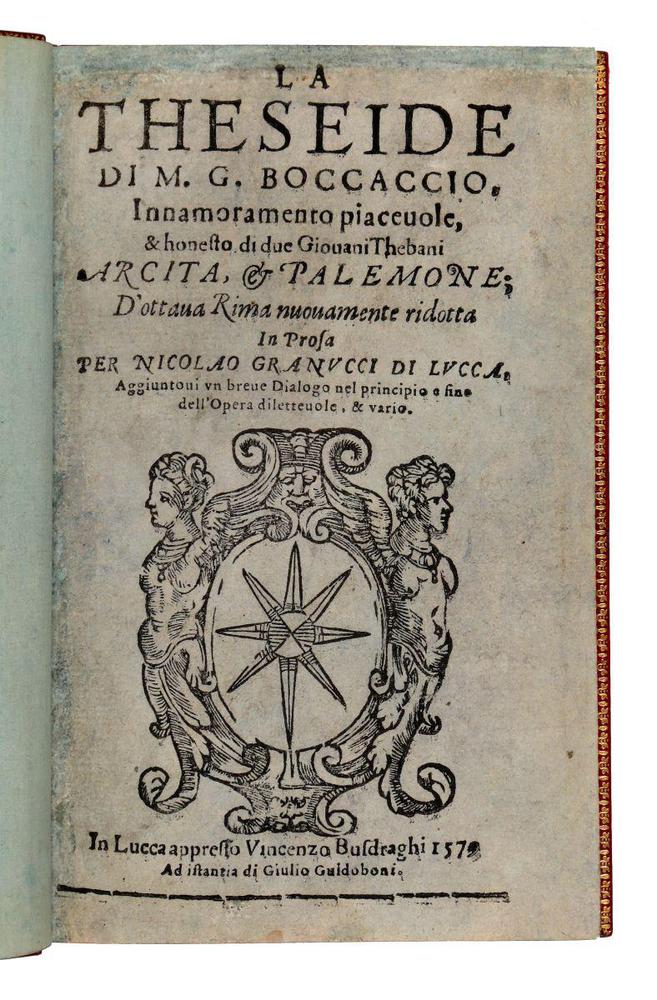[Blue paper] Boccaccio, Giovanni (1313-1375). La Theseide... Innamoramento piaceuole... Lucca, Vincenzo Busdraghi for Giulio Guidoboni, 1579.




[Blue paper] Boccaccio, Giovanni (1313-1375). La Theseide... Innamoramento piaceuole... Lucca, Vincenzo Busdraghi for Giulio Guidoboni, 1579.
Boccaccio, Giovanni (1313-1375).
La Theseide... Innamoramento piaceuole, & honesto di due Giouani Thebani Arcita & Palemone; D’ottaua Rima nuouamente ridotta In Prosa per Nicolao Granucci di Lucca. Aggiuntoui un breve Dialogo nel principio e fine dell’Opera diliteuole, & vario.
Lucca, Vincenzo Busdraghi for Giulio Guidoboni, 1579.
A sixteenth-century Lucca edition,
from the library of Guglielmo Libri
Boccaccio, Giovanni (1313-1375).
La Theseide... Innamoramento piaceuole, & honesto di due Giouani Thebani Arcita & Palemone; D’ottaua Rima nuouamente ridotta In Prosa per Nicolao Granucci di Lucca. Aggiuntoui un breve Dialogo nel principio e fine dell’Opera diliteuole, & vario. Lucca, Vincenzo Busdraghi for Giulio Guidoboni, 1579.
8° (154x100 mm). Printed on blue paper. Collation: a8, A-S8 (fol. F4 signed G4). 8, 144 leaves. Roman and italic type. Woodcut printer’s device on the title-page. Woodcut decorated seven-line initials and headpieces. Fine Parisian red morocco over pasteboards, signed by Hippolyte Duru, and executed in 1847. Covers within double blind fillet. Spine with five small raised bands, emphasized by blind fillets; title lettered in gold. Marbled pastedowns and flyleaves; board edges decorated with gilt fillets, inside dentelles. Gilt edges. A good copy; upper margin of leaves restored, some letters of the running titles reconstructed at the time of binding.
Provenance: Guglielmo Libri (1803-1869; Catalogue de la Bibliothèque de M L**, Paris 1847, lot 2299, “La Theseide, di Gio Boccaccio... Lucca, Vinc. Busdraghi, 1579, in 8. Mar. r. d. Duru. Exemplaire en papier bleu de cette ouvrage curieux”. Sold for 40 francs).
Very rare edition of Boccaccio’s Teseida, presented here in a fine binding executed for Guglielmo Libri by the renowned Parisian binder Hippolyte Duru.
Boccaccio composed the Teseida to demonstrate that a classical epic could be written in vernacular language. The text was produced in three redactions, the first beginning in the early 1340s, and the second and third in the late 1340 and early 1350s. On the model of Virgil’s Aeneis, the poem is divided into twelve books, and consists of 1,238 octaves. The Teseida combines elements from the classical epics and the contemporary tradition of love literature, and was first printed in Ferrara in 1475, edited on the basis of a contaminated text assembled by the Ferrarese Pietro Andrea de’ Bassi. After the Venetian edition of 1529, the Teseida appeared again in Italy only fifty years later, thanks to Nicolò Granucci, who rewrote the text in prose. Boccaccio’s work had notable popularity in medieval English literature, and served as a primary source for Geoffrey Chaucer’s Knight’s Tale, included in his Canterbury Tales. “Several books occupied Chaucer’s desk while he was composing The Knight’s Tale [...] The most important book on that very crowded desk was the Teseida” (Coleman, The Knight’s Tale, p. 87).
In the annals of Lucchese printer Vincenzo Busdraghi, or Busdrago (1524-1594), Matteucci states that a few copies of the Teseida were issued on carta cerulea.
STC Italian 112; L. Matteucci, “Saggio di un Catalogo delle Edizioni Lucchesi di Vincenzo Busdrago (1549-1605)”, La Bibliofilia, 18 (1917), no. 93; D. Anderson, Before the Knight’s Tale. Imitation of Classical Epic in Boccaccio’s “Teseida”, Philadelphia 1988; W. E. Coleman, “The Knight’s Tale”, R. M. Correale – M. Hamel (eds.), Sources and Analogues of the Canterbury Tales, Cambridge 2005, 2, pp. 87-124; R. Daniels, Boccaccio and the Book, London 2009, p. 57; W. E. Coleman, “Teseida delle nozze d’Emilia”, T. De Robertis – C. M. Monti et al. (eds.), Boccaccio autore e copista, Firenze 2013, pp. 89-99.



